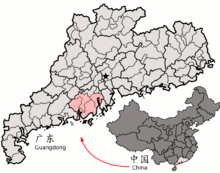Siyi
| Sze Yup | |||||||||||||||||
 Sze Yup location in Guangdong | |||||||||||||||||
| Chinese | 四邑 | ||||||||||||||||
|---|---|---|---|---|---|---|---|---|---|---|---|---|---|---|---|---|---|
| Literal meaning | four counties | ||||||||||||||||
| |||||||||||||||||
The Siyi or Four Counties, also known by various Cantonese romanizations such as Sze Yup and Seiyap refers to the four former counties of Xinhui (Sunwui), Taishan (Toisan), Kaiping (Hoiping) and Enping (Yanping) in the Pearl River Delta of southern Guangdong province, China.[1][2]
Geography
Xinhui is a city district and the other three are county-level cities, all four belong to Jiangmen prefecture administered from the city of Jiangmen. Since Heshan became governed by Jiangmen in 1983, Wuyi (Chinese: 五邑; pinyin: Wǔyì; literally: "five counties", sometimes "Ng Yap"), which refers to all the five counties of Xinhui, Taishan, Kaiping, Enping and Heshan, has become an official title, and is widely accepted by the local residents today. However, among overseas Chinese, the name Siyi (Cantonese: Sze Yup) is still popular and frequently used.
It is said that over 100 famous people come from the Siyi or Wuyi region of Guangdong province, making the region famous for producing more entertainment stars than any other region in mainland China. As a result, the local government in Jiangmen which administers the Siyi or Wuyi cities of Taishan, Kaiping, Enping, Xinhui, and Heshan, decided to build a Stars Park called Jiangmen Star Park.
Dialects
The area gave rise to the Siyi dialects, the most prominent of which is Taishanese (Toisanese/Hoisanese). Although Siyi and Cantonese both belong to the Yue branch of Chinese, Cantonese speakers cannot easily understand Siyi dialect.[3][4][5]
Emigration
In the late 19th century and early 20th century, many people from the Siyi (or Sze Yup as it was then known) emigrated to Hong Kong, Southeast Asia, Australasia, North America and South America. Of the Chinese American population from that time until the 1950s, Sze Yup accounted for the vast majority, about 80%, along with people from Sanyi (Sam Yup) and Zhongshan.[6]
In America, people from Siyi (Sze Yup) generally worked as laborers; Sanyi (Sam Yup) people worked as entrepreneurs; and Zhongshan people specialized in agriculture.[7] The Punti-Hakka Clan Wars also erupted in the Siyi counties just prior to this time period of emigration.[8] In 1851, two huiguans (native place associations) were established in San Francisco: the Siyi Huiguan and the Sanyi Huiguan.[9] Endowed with only limited arable lands, with much of the terrain either rocky or swampy, Siyi (Sze Yup) was the "pre-eminent sending area" of overseas Chinese.[6]
In addition to being a region of major emigration abroad, Siyi (Sze Yup) is a melting pot of ideas and trends brought back by overseas Chinese. For example, many tong lau in Chikan, Kaiping and diaolou in Kaiping and Taishan built in the early 20th century incorporate architectural features from both China and the West.[10]
References
- ↑ Chinese American Names: Tradition and Transition - Page 118 Emma Woo Louie - 2008 "These were the Sam Yup and Sze Yup dialects, which the author spelled as “Saam Yup” and “Sz Yip,” respectively. Sam Yup means “Three Districts dialect,” which is akin to standard Cantonese, and Sze Yup means “Four Districts dialect.”
- ↑ Shanghai Girls - Page 8 Lisa See - 2010 "My first language was Sze Yup, the dialect spoken in the Four Districts in Kwangtung province, where our ancestral home is located...”
- ↑ Szeto, Cecilia (2001), "Testing intelligibility among Sinitic dialects", in Allan, Keith; Henderson, John, Proceedings of ALS2k, the 2000 Conference of the Australian Linguistic Society (PDF), retrieved 5 Jan 2014
- ↑ Phonology of Cantonese - Page 192 Oi-kan Yue Hashimoto - 1972 "... affricates and aspirated stops into consonant clusters is for external comparative purposes, because the Cantonese aspirated stops correspond to /h/ and some of the Cantonese affricates correspond to stops in many Si-yi (Seiyap) dialects."
- ↑ Language in the USA - Page 217 Charles A. Ferguson, Shirley Brice Heath, David Hwang - 1981 "Even the kind of Cantonese which the Chinese Americans speak causes difficulties, because most of them have come from the rural Seiyap districts southwest of Canton and speak dialects of that region rather than the Standard Cantonese of the city"
- 1 2 Pan, Lynn (1999). The Encyclopedia of the Chinese Overseas. Cambridge, MA: Harvard University Press. p. 36. ISBN 0674252101.
- ↑ Hsia, Lisa (2007). "Asians and Asian Americans in the West". In Mancall, Peter; Johnson, Benjamin Heber. Making of the American West: People and Perspectives. ABC-CLIO. pp. 161–187.
- ↑ Punti-Hakka Clan Wars and Taishan County Archived 2007-09-10 at the Wayback Machine.
- ↑ Chi, Tsung (2005). East Asian Americans and Political Participation: A Reference Handbook. ABC-CLIO. p. 65.
- ↑ Pan, Lynn (1999). The Encyclopedia of the Chinese Overseas. Cambridge, MA: Harvard University Press. pp. 28–29. ISBN 0674252101.